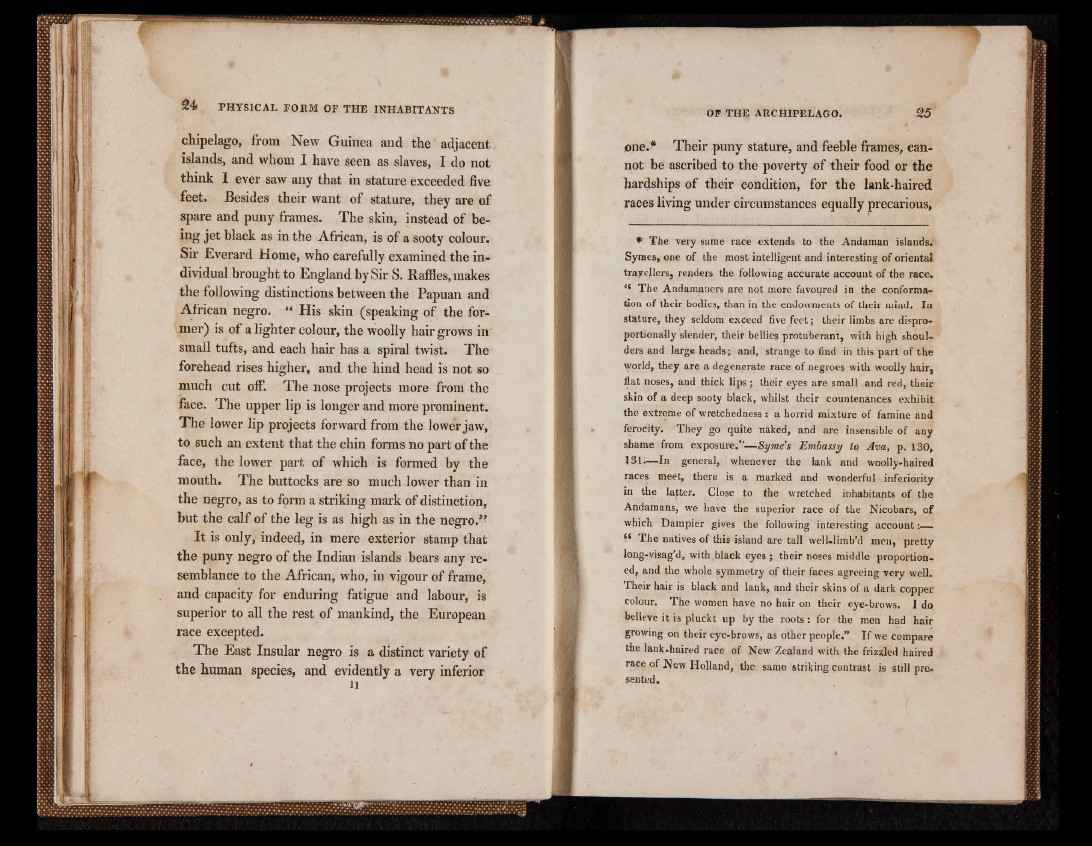
chipelago, from New Guinea and the adjacent
islands, and whom I have seen as slaves, I do not
think I ever saw any that in stature exceeded five
feet. Besides their want of stature, they are of
spare and puny frames. The skin, instead of being
jet black as in the African, is of a sooty colour.
Sir Everard Home, who carefully examined the individual
brough t to England by Sir S. Raffles, makes
the following distinctions between the Papuan and
African negro. ** His skin (speaking of the former)
is of a lighter colour, the woolly hair grows in
small tufts, and each hair has a spiral twist. The
forehead rises higher, and the hind head is not so
much cut off. The nose projects more from the
face. The upper lip is longer and more prominent.
The lower lip projects forward from the lower jaw,
to such an extent that the chin forms no part of the
face, the lower part of which is formed by the
mouth. The buttocks are so much lower than in
the negro, as to form a striking mark of distinction,
but the calf of the leg is as high as in the negro.’’
It is only, indeed, in mere exterior stamp that
the puny negro of the Indian islands bears any resemblance
to the African, who, in vigour of frame,
and capacity for enduring fatigue and labour, is
superior to all the rest of mankind, the European
race excepted.
The East Insular negro is a distinct variety of
the human species, and evidently a very inferior
11
¡one.* Their puny stature, and feeble frames, cannot
be ascribed to the poverty of their food or the
hardships of their condition, for the lank-haired
races living under circumstances equally precarious,
* The very same race extends to the Andaman islands.
Synaes, one of the most intelligent and interesting of oriental
travellers, renders the following accurate account of the race.
,e The Andamaners ¡are not more favoured in the conformation
of their bodies, than in the endowments of their mind. In
stature, they seldom exceed five feel; their limbs are dispro-
portionally slender, their bellies protuberant, with high shoulders
and large heads; and, strange to find in this part of the
world, they are a degenerate race of negroes with woolly hair,
flat noses, and thick lip s; their eyes are small and red, their
skin of a deep sooty black, whilst their countenances exhibit
the extreme of wretchedness: a horrid mixture of famine and
ferocity. They go quite naked, and are insensible of any
shame from exposure."—Syme's Embassy to Ava, p. 130,
131.—In general, whenever the lank and woolly-haired
races meet, there is a marked and wonderful inferiority
in the latter. Close to the wretched inhabitants of the
Andamans, we have the superior race of the Nicobars, of
which Dampier gives the following interesting account;—
fc The natives of this island are tall well-limb’d men, pretty
long-visag’d, with black eyes ; their noses middle proportioned,
and the whole symmetry qf their faces agreeing very well.
Their hair is black and lank, and their skins of a dark copper
colour. The women have no hair on their eye-brows. I do
believe it is pluckt up by the roots: for the men had hair
growing on their eye-brows, as other people.” If we compare
the lank-haired race of New Zealand with the frizzled haired
race of New Holland, the same striking contrast is still presented.